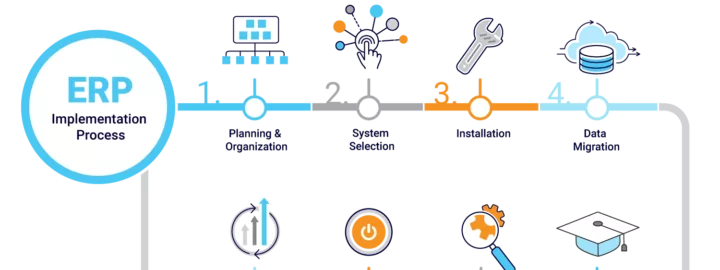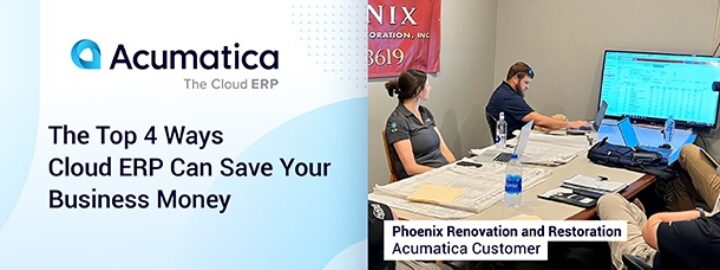Reviewed: Jan, 2023
Does your ERP vendor let you change your ERP deployment method after your cloud ERP implementation is complete—without penalty? Acumatica does.

Here is a potentially scary scenario for you. You are a small-to-midsize business (SMB) that, after getting your leadership and IT buy-in, has invested into a modern cloud ERP solution and has undergone the often complicated and time-consuming cloud ERP implementation. Everything goes well … UNTIL you realize your deployment option is no longer going to work.
What do you do?
It all depends on your ERP provider. In a perfect world, you would have chosen one that considers ERP deployment flexibility a right of every customer. That ERP (Enterprise Resource Planning) provider is Acumatica.
Choosing Acumatica cloud ERP and deployment flexibility
Every SMB knows that change is inevitable, from changes in your industry or compliance regulations to changing customer demands and internet reliability/access. Here at Acumatica, we understand your business must flex with the changes, including how you deploy our ERP solution. This is why we guarantee ERP deployment flexibility, which is right #6 in Acumatica’s Customer Bill of Rights. We also guarantee when you change your deployment option, you won’t be penalized.
As an Acumatica customer, you can deploy via Acumatica SaaS (Software-as-a-Service) or private cloud. If you’re not sure which one is best for your business, let’s look at some pros and cons of each option.
SaaS deployment
With SaaS, Acumatica uses AWS to host our cloud ERP software, which we maintain and update, including computer hardware and operation system updates.
Pros:
- No up-front capital expenditure, freeing up cash for other investments.
- Servers are maintained in a controlled environment in the data center, making technical resources available for more critical duties.
- Software updates can be scheduled automatically without involvement from your IT team.
- The AWS hosting provider employs enterprise-level security and virus protection that most companies can’t afford. They also offer geographically dispersed data centers, backup/restore capabilities, and system redundancy.
- SaaS deployments offer flexible scalability.
Cons:
- Loss of internet connectivity can leave users unable to access the system.
Private cloud deployment
For SMBs, this option means you purchase the computers that will run Acumatica’s cloud ERP (Enterprise Resource Planning) software, and you will store them in your facility or work with a hosting partner (AWS or Azure, for example).
Pros:
- Companies choose to deploy on premises for several reasons, such as regulatory compliance.
- Private deployment gives you complete control of and access to the system.
Cons:
- Private cloud deployment requires more upfront and long-term capital investment to purchase the server hardware as well as the staff and facilities to maintain them.
- You are responsible for all network security and access risks, including backup/restore procedures and system failover capabilities.
- You are responsible for making sure upgrades take place as new releases become available. You can perform upgrade tasks using your team or work with your Acumatica partner for assistance.
In addition to the aforementioned pros and cons of each option, it’s important to note that having your financial data in the cloud is not “riskier” than having it under your control in a private cloud deployment. Third-party cloud providers are able to offer a high-level of security that you may not be able to afford on your own.
SMBs that chose Acumatica cloud ERP
Acumatica customer Aimtec, a global power supply component manufacturer, implemented Acumatica in 2013, replacing SAGE Peachtree and QuickBooks. They chose the SaaS option and found that the move to a cloud-based ERP solution was exactly what they needed.
“Having a VPN connection connecting employees outside of the office with the server definitely was a disadvantage, compared to a cloud solution,” says CEO and President Vladimir Serafimov in the company’s customer success story. “I like Acumatica. The system overall is very advanced. I would say that it’s really worth it. For me, it was a good choice; I’m not disappointed.”
Aimtec hasn’t had to switch their deployment option yet, but if the need arises, they can—something another Acumatica customer may be taking advantage of in the future.
xByte Technologies, a company that provides refurbished Dell servers and network switches, has been an Acumatica customer for years. Because they had accessible and inexpensive hardware at their disposal but needed the mobile capabilities of the cloud, they chose a hybrid ERP deployment.
“The key thing for us with Acumatica is that not only was it web-based, but it wasn’t purely cloud. We liked that we could control it ourselves, so we bought the on-premises model,” says CEO Ryan Brown in the company’s Acumatica customer success story.
Even though xByte, Acumatica’s 2017 Customer of the Year, has improved visibility, efficiency, and customer service (something they already excel at) with a hybrid Acumatica cloud ERP model, Ryan says they may consider switching to a full SaaS deployment. Should that decision be made, they know they can do it when they want at no cost to them.
Listen as Ryan discusses his ERP deployment flexibility with Acumatica.
Is it time to consider Acumatica and ERP deployment flexibility?
If having ERP deployment flexibility (which means switching deployment options when you need and want to with no penalty) is important to you, then you may want to consider Acumatica cloud ERP. We know being agile in an ever-changing marketplace is foundational to your success.
To learn more about ERP deployment flexibility and about Acumatica ERP implementations (which includes these eight steps to success), contact our team today. We would be happy to schedule a demonstration to help you in your ERP selection process.
 Canada (English)
Canada (English)
 Colombia
Colombia
 Caribbean and Puerto Rico
Caribbean and Puerto Rico
 Ecuador
Ecuador
 India
India
 Indonesia
Indonesia
 Ireland
Ireland
 Malaysia
Malaysia
 Mexico
Mexico
 Panama
Panama
 Peru
Peru
 Philippines
Philippines
 Singapore
Singapore
 South Africa
South Africa
 Sri Lanka
Sri Lanka
 Thailand
Thailand
 United Kingdom
United Kingdom
 United States
United States















